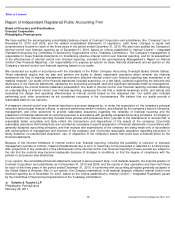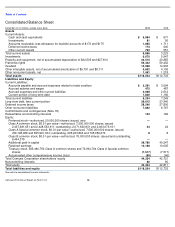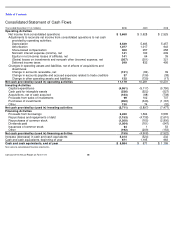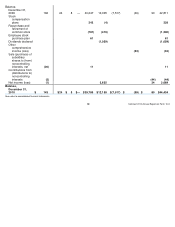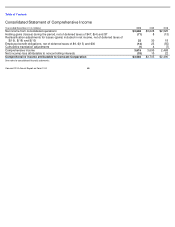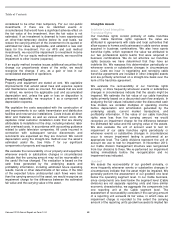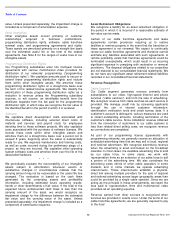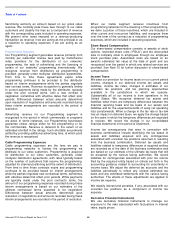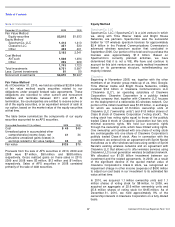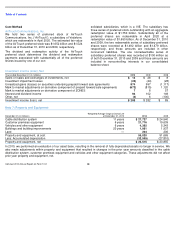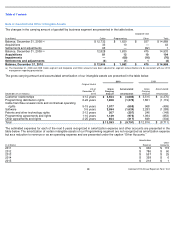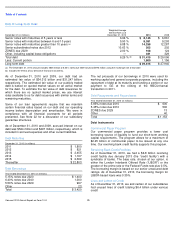Comcast 2010 Annual Report Download - page 71
Download and view the complete annual report
Please find page 71 of the 2010 Comcast annual report below. You can navigate through the pages in the report by either clicking on the pages listed below, or by using the keyword search tool below to find specific information within the annual report.
Table of Contents
Comcast 2010 Annual Report on Form 10-K
62
considered to be other than temporary. For our non-public
investments, if there are no identified events or
circumstances that would have a significant adverse effect on
the fair value of the investment, then the fair value is not
estimated. If an investment is deemed to have experienced
an other-than-temporary decline below its cost basis, we
reduce the carrying amount of the investment to its quoted or
estimated fair value, as applicable, and establish a new cost
basis for the investment. For our AFS and cost method
investments, we record the impairment to investment income
(loss), net. For our equity method investments, we record the
impairment to other income (expense).
If an equity method investee issues additional securities that
change our proportionate share of the entity, we would
recognize the change, if any, as a gain or loss in our
consolidated statement of operations.
Property and Equipment
Property and equipment are stated at cost. We capitalize
improvements that extend asset lives and expense repairs
and maintenance costs as incurred. For assets that are sold
or retired, we remove the applicable cost and accumulated
depreciation and, unless the gain or loss on disposition is
presented separately, we recognize it as a component of
depreciation expense.
We capitalize the costs associated with the construction of
and improvements to our cable transmission and distribution
facilities and new service installations. Costs include all direct
labor and materials, as well as various indirect costs. We
capitalize initial customer installation costs that are directly
attributable to installation of the drop, including material, labor
and overhead costs, in accordance with accounting guidance
related to cable television companies. All costs incurred in
connection with subsequent service disconnects and
reconnects are expensed as they are incurred. We record
depreciation using the straight-line method over the asset’s
estimated useful life. See Note 7 for our significant
components of property and equipment.
We evaluate the recoverability of our property and equipment
whenever events or substantive changes in circumstances
indicate that the carrying amount may not be recoverable or
the useful life has changed. The evaluation is based on the
cash flows generated by the underlying assets and
profitability information, including estimated future operating
results, trends or other determinants of fair value. If the total
of the expected future undiscounted cash flows were less
than the carrying amount of the asset, we would recognize an
impairment charge for the difference between the estimated
fair value and the carrying value of the asset.
Intangible Assets
Indefinite-Lived Intangibles
Franchise Rights
Our franchise rights consist primarily of cable franchise
rights. Cable franchise rights represent the value we
attributed to agreements with state and local authorities that
allow access to homes and businesses in cable service areas
acquired in business combinations. We also have sports
franchise rights, which represent the value we attributed to
our two professional sports teams that were acquired in
business combinations. We do not amortize our franchise
rights because we have determined that they have an
indefinite life. We reassess this determination periodically or
whenever events or substantive changes in circumstances
occur. Costs we incur in negotiating and renewing cable
franchise agreements are included in other intangible assets
and are primarily amortized on a straight-line basis over the
term of the franchise agreement.
We evaluate the recoverability of our franchise rights
annually, or more frequently whenever events or substantive
changes in circumstances indicate that the assets might be
impaired. We estimate the fair value of our cable franchise
rights primarily based on a discounted cash flow analysis. In
analyzing the fair values indicated under the discounted cash
flow models, we consider multiples of operating income
before depreciation and amortization generated by the
underlying assets, current market transactions, and
profitability information. If the value of our cable franchise
rights were less than the carrying amount, we would
recognize an impairment charge for the difference between
the estimated fair value and the carrying value of the assets.
We also evaluate the unit of account used to test for
impairment of our cable franchise rights periodically or
whenever events or substantive changes in circumstances
occur to ensure impairment testing is performed at an
appropriate level. The Cable divisions represent the unit of
account we use to test for impairment. In November 2010,
our Cable division management structure was reorganized
from four divisions to three. We re-performed our impairment
testing immediately before the reorganization and no
impairment was indicated.
Goodwill
We assess the recoverability of our goodwill annually, or
more frequently whenever events or substantive changes in
circumstances indicate that the asset might be impaired. We
generally perform the assessment of our goodwill one level
below the operating segment level. In our Cable business,
since components one level below the segment level (Cable
divisions) are not separate reporting units and have similar
economic characteristics, we aggregate the components into
one reporting unit at the Cable segment level. The
assessment of recoverability considers if the carrying amount
of a reporting unit exceeds its fair value, in which case an
impairment charge is recorded to the extent the carrying
amount of the reporting unit’s goodwill exceeds its implied fair



